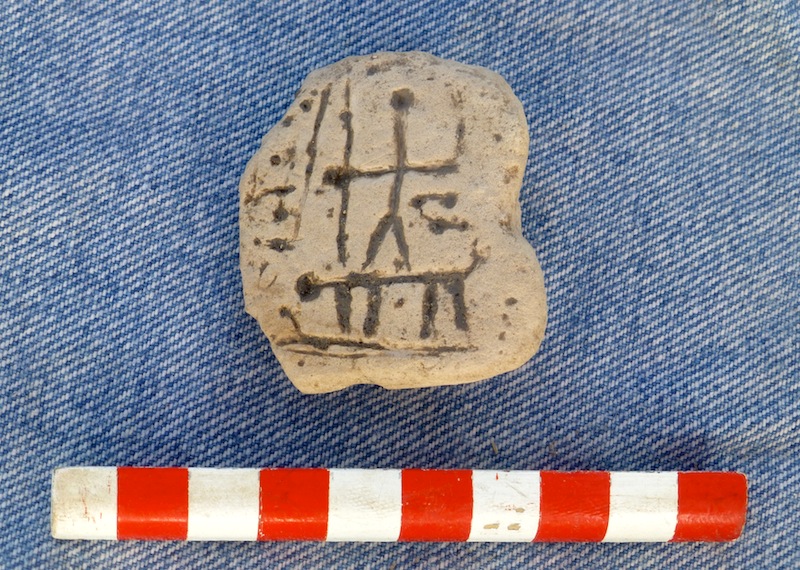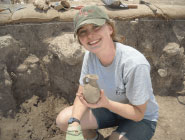Tel Beth-Shemesh —
After the Philistines had captured the Ark of the Covenant, they faced all sorts of problems. They took the Ark to the temple of their god Dagon. The next morning they found the statue of Dagon had fallen on the floor in front of the Ark. They set it back up, but the next morning they found it had fallen again, and its head and arms were broken off. Then the people of the town began to have sores, and mice were running everywhere. They then sent the Ark to Gath, and the people of Gath began to have sores and mice were everywhere. They sent the Ark to Ekron and the people believed the Ark was brought there to kill them. Sores and mice spread throughout the land.
While we were cleaning up to begin excavation for the 2014 season, this seal was discovered. It is of a person, probably holding a weapon (spear?) standing on the back of an animal of some kind (the specialist has suggested that it might be a lion. This dates from the Iron Age I (ca. 1200-1000 BC).
The Philistines finally decided to send the Ark back to the Israelites. They made gold images of the thing which had troubled them as an offering to God. They put the Ark and gold images in a wagon and hitched up two cows to pull the ark. The cows started down the road to Israel and did not stop until they came to Beth Shemesh.
Today the biblical city of Beth Shemesh is Tel Beth-Shemesh, and it is located near the modern-day city of Beth-Shemesh.
Tel Beth-Shemesh is an important biblical site in the northeastern Shephelah (lowland) of Judah. It is a 7-acre mound located about 12 miles west of Jerusalem and overlooks the Sorek Valley. Situated at the geographical, political and cultural border, as well as the meeting point between Canaanites, Philistines and Israelites, Beth-Shemesh was the scene of great historical events and cultural changes. It is therefore an ideal site for the investigation of key historical and cultural issues relating to the vexed relations and interaction between these three peoples.
In 2010 Sarah Yeager of Harding
discovered a very nice,
fully intact juglet that did not have a scratch on it.
The name Beth-Shemesh ("House of the Sun") is suggestive of the deity that was worshipped by the Canaanite inhabitants of the ancient city. Identification of the mound with biblical Beth-Shemesh is based on its geographical description in the Bible, on Byzantine sources and on the name of the nearby Arab village 'Ain Shems, which preserved the ancient name.
The Bible mentions Beth-Shemesh in the description of the northern border of the Tribe of Judah (Joshua 15: 10-11) and as a Levitical city in the territory of Judah (Joshua 21: 16). Following the battle of Ebenezer and the capture of the Ark of the Covenant by the Philistines, the ark was returned to Beth-Shemesh (1 Samuel 6: 9-18). The town is listed in Solomon's second administrative district (1 Kings 4: 9), and it was here that the battle between Joash, king of Israel, and Amaziah, king of Judah, took place (2 Kings 14: 11-13). Shortly thereafter, Beth-Shemesh passed into Philistine control, but was restored to the Kingdom of Judah under Hezekiah (2 Chronicles 28: 18). The town was destroyed by Sennacherib, king of Assyria, during his campaign in Judah, in 701 BC.
Dr. Manor shows hummus which is raised in the area of Beth-Shemesh.
Excavations were conducted at Tel Beth-Shemesh in 1911-1912 by D. Mackenzie on behalf of the Palestine Exploration Fund (PEF) and in 1928-1933 by E. Grant from Haverford College, Penn.
New excavations were initiated in 1990 by Shlomo Bunimovitz and Zvi Lederman of the Institute of Archaeology of Tel Aviv University. Dr. Dale Manor joined them in 1990 as field director.
Return to Top of Page